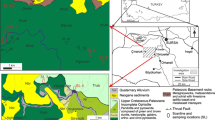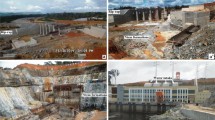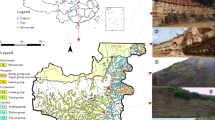Abstract
The aim of this paper is to demonstrate the controlling effect of the mineral composition, the diagenetic history and the petrophysical properties on the geomechanical properties and durability of the dolomitic El-Halal Formation in its type section in North Sinai as well as its economic potential for construction purposes. The petrographic studies include descriptions of both the mineral composition and diagenetic processes, while the petrophysical studies measure the density, porosity, permeability and true formation resistivity factor. In addition, some geomechanical laboratory tests were conducted, including the petrographic description of the mineral composition and diagenetic processes, as well as the Schmidt Hammer number (SHV), point load index (IS50), uniaxial compressive strength (UCS), and ultrasonic longitudinal wave velocity measurements. Scanning electron microscopy was used to help in pore-type description (intergranular, vuggy, etc.). Based on lithologic changes and mineral composition, the El-Halal Formation can be subdivided into three informal members: (1) lower dolomitic limestone, (2) middle sandy dolostone and (3) upper dolostone member. Petrographically, the sequence consists of three dominant microfacies: (1) dolomitic mudstone microfacies (dolomitic micrite to dolomicrite), (2) dolowackestone (clayey to sandy dolomicrite), and (3) dolomudstone microfacies (dolosparite). The most diagnostic diagenetic processes are dolomitization, cementation by calcite, aggrading neomorphism and the creation of authigenic illite. In the study area, dolomitization has affected almost all the Cenomanian succession. The SHV, IS50, and UCS values of the samples indicate high-strength rocks. The present study indicates the dependence of the geomechanical properties on the petrophysical properties and the mineral composition of the studied rocks. Modeling the properties indicates a reliable correlation between the different parameters which can be applied for predicting and characterizing the dolomitic El-Halal Formation elsewhere. The results of the present investigation are useful for studying the geomechanical and petrophysical properties of similar dolomitic sequences and in ranking its potential as construction materials.








Similar content being viewed by others
References
Abd El Aal A, Nabawy BS (2017) Implications of increasing the ferruginous cement on the physical and mechanical properties of the Cambro-Ordovician Wajid sandstone in Southwest Saudi Arabia: applications for construction purposes. Bull Eng Geol Environ. https://doi.org/10.1007/s10064-017-1115-3
Abdullatif OM (2009) Geomechanical properties and rock mass quality of the carbonate Rus formation, Dammam dome, Saudi Arabia. Arab J Sci Eng 35:173–197
Ahr WM (2005) Carbonate Reservoir Geology. Texas A&M University. class notes, College Station
Aly MF, Abdel-Gawad GI, Gabir MA (2005) Upper most Albian-Cenomanian ammonites from North Sinai. Egypt Egy J Paleont 5:347–385
Ameen MS, Brian GD, Somerville JM (2009) Predicting rock mechanical properties of carbonates from wireline logs (a case study: Arab-D reservoir, Ghawar field, Saudi Arabia). Mar Pet Geol 26:430–444
American society for testing and materials (ASTM) (1984) Soil and rock, building stones: Annual Book of ASTM Standards, 4.08
Anon (1979) Classification of rocks and soils for engineering geological mapping, part 1-rock and soil materials. Rep Comm Eng Geol Mapp Bull Int Asso Eng Geol 19:364–371
Arman H, Hashem W, El Tokhi M, Abdelghany O, El Saiy A (2014) Petrographical and geomechanical properties of the lower Oligocene limestones from al Ain City, United Arab Emirates. Arab J Sci Eng 39(1):261–271
Benavente D, Garcia del Cura MA, Fort R, Ordóñez S (2004) Durability estimation of porous building stones from pore structure and strength. Eng Geol 74:113–127
Benson DJ (1985) Diagenetic controls on reservoir development and quality, Smackover Formation of southwest Alabama. Gulf Coast Assoc Geol Soc Trans 35:317–326
Biju-Duval B, Letouzey J, Montadert L (1979) Variety of margins and deep basins in the Mediterranean: in geological and geophysical investigations of continental margins. AAPG Bull M 29:293–317
Boadu FK (1997) Fractured rock mass characterization parameters and seismic properties: analytical studies. J Appl Geophys 36:1–19
Broch EM, Franklin JA (1972) The point load strength test. Int J Rock Mech Min Sci 9:669–697
Chang C, Zoback M, Khaksar A (2006) Empirical relations between rock strength and physical properties in sedimentary rocks. J Pet Sci Eng 51:223–237
Çobanoğlu I, Çelik SB (2008) Estimation of uniaxial compressive strength from point load strength, Schmidt hardness and P-wave velocity. Bull Eng Geol Environ 67(4):491–498
Fitzner B, Snethlage R (1982) Zum EinfluB der Porenradienverti. Eilung auf das Verwitterungsverhalten ausgewa¨hlter Sandsteine. Bautenschult Bausan 3(82):97–102
Genedi A (1998) Formation of the upper cretaceous cherts in northeastern Sinai, Egypt. J Afr Earth Sci 26(2):297–311
Hudson JA, Jones ETW, New BM (1980) P-wave velocity measurements in a machine bored chalk tunnel. Q J Eng Geol 13:33–43
ISRM (1981) In: E.T. Brown (ed.) Rock characterization testing and monitoring-ISRM suggested methods. Pergamon, New York
Kahraman S, Yeken T (2008) Determination of physical properties of carbonate rocks from P-wave velocity. Bull Eng Geol Environ 67:277–281
Kahraman S, Soylemez M, Fener M (2008) Determination of fracture depth of rock blocks from P-wave velocity. Bull Eng Geol Environ 67(1):11–16
Karpuz C, Pasamehmetoglu AG (1997) Field characterization of weathered Ankara andesites. Eng Geol 46:1–17
Kelsall PC, Watters R, Franzone JG (1986) Engineering characterization of fissured, weathered dolerite and vesicular basalt. Proc. 27th U.S. Symposium 77–84
Klinkenberg LJ (1941) The permeability of porous media to liquids and gases, in drilling and production practice 2. Am Petrol Ins:200–213
Kora M, Shahin A, Semiet A (1994) Biostratigraphy and paleoecology of some Cenomanian successions in west Central Sinai, Egypt. Neues Jahrb Geol Paläontol Mh H 10:597–617
Kuşcu M, Yıldız A, Bağcı M (2003) Investigation of Ağın andesite as a building stone (İscehisar-Afyon, W-Turkey). International symposium on industrial minerals and building stones, İstanbul, pp 243–253
Larsen B, Gudmundsson A, Grunnaleite I, Sælen G (2010) Effects of sedimentary interfaces on fracture pattern, linkage, and cluster. Mar Pet Geol 27:1531–1550
Miller RP (1965) Engineering classification and index properties for intact rocks. PhD thesis, University of Illinois
Moustafa AR, Khalil MH (1990) Structural characteristics and tectonic evolution of north Sinai fold belts. In: Said R (ed.) The geology of Egypt. Balkema, Rotterdam, pp 381–389
Nabawy BS (2013) Impacts of dolomitization on the petrophysical properties of the Cenomanian el-halal formation, North Sinai, Egypt. Arab J Geosci 6(2):359–373
Nabawy BS (2014) Estimating porosity and permeability using digital image analysis (DIA) technique for highly porous sandstones. Arab J Geosci 7(3):889–898
Nabawy BS (2015) Impacts of the pore- and petro-fabrics on porosity exponent and lithology factor of Archie’s equation for carbonate rocks. J Afr Earth Sci 108:101–114
Nabawy BS, Al-Azazi NAS (2015) Reservoir zonation and discrimination using the routine core analyses data: the upper Jurassic Sab’atayn sandstones as a case study, Sab’atayn basin, Yemen. Arab J Geosci 8(8):5511–5530
Nabawy BS, Barakat MK (2017) Formation evaluation using conventional and special core analyses: Belayim formation as a case study, gulf of Suez, Egypt. Arab J Geosci 10:25
Nabawy BS, Sediek KN, Nafee SA (2015) Pore fabric assignment using electrical conductivity of some Albian–Cenomanian sequences in north Eastern Desert, Egypt. Arab J Geosci 8(8):5601–5615
Nabway BS, Kassab MA (2014) Porosity-reducing and porosity-enhancing diagenetic factors for some carbonate microfacies: a guide for petrophysical facies discrimination. Arab J Geosci 7(11):4523–4539
Shahin A (2001) Contribution to the knowledge of the early cretaceous foraminiferal assemblages, their paleoecology and paleogeography in the northern Sinai, Egypt. NJ Geol Palaeont 221:397–440
Shalabi FI, Cording EJ, Al-Hattamleb OH (2007) Estimation of rock engineering properties using hardness tests. Eng Geol 90:138–147
Sharma PK, Singh TN (2008) A correlation between P-wave velocity, impact strength index, slake durability index and uniaxial compressive strength. Bull Eng Geol Environ 67:17–22
Singh YR, Devi CO, Abujam SS, Chetia D (2012a) Study on the ethnomedicinal system of Manipur. Int J Pharm Biol Arch 3(3):587–591
Singh E, Sharma S, Dwivedi J, Sharma S (2012b) Diversified potentials of Ocimum sanctum Linn (Tulsi): an exhaustive survey. J Nat Prod Plant Res 2:39–48
Sun Y, Jiang J, Kantarelis E, Xu J, Li L, Zhao S, Yang W (2012) Development of a bimetallic dolomite based tar cracking catalyst. Catal Commun 20:36–40
Teme SC, Edet AE (1986) Strength characteristics of some Nigerian limestone implications for the construction industry. In: Proc regional seminar in earth sciences, 1st ANSTI-UNESCO earth sciences subnetwork, Dakar 8–17
Turk N, Dearman WR (1987) Assessment of grouting efficiency in a rock mass in terms of seismic velocities. Bull Int Assoc Eng Geol 36:101–108
Wacey D, Wright D, Boyce A (2007) A stable isotope study of microbial dolomite formation in the Coorong region, South Australia. Chem Geol 244:155–174
Walsh JB, Brace WF (1984) The effect of pressure on porosity and the transport properties of rock. J Geophy Res 89(Bll):9425–9431
Wanas HA (2008) Cenomanian rocks in the Sinai peninsula, Northeast Egypt: facies analysis and sequence stratigraphy. J Afr Earth Sci 52:125–138
Zico A, Darwish M, Eweda S (1993) Late cretaceous-early tertiary stratigraphy of the themed area, east Central Sinai, Egypt. Neues Jahrbruch für Geologie und Paläontologie, Monatshefte 3:135–149
Acknowledgements
I would like to thank the reviewers for their constructive comments that improved and reconstructed the manuscript. Thanks are also due to the editors, Prof. Dr. Martin G. Culshaw and Prof Dr. Philip Paige-Green, whose patience and insightful suggestions have led to a concise revised version.
Author information
Authors and Affiliations
Corresponding author
Rights and permissions
About this article
Cite this article
Nabawy, B.S., El Aal, A.A. Impacts of the petrophysical and diagenetic aspects on the geomechanical properties of the dolomitic sequence of Gebel El-Halal, Sinai, Egypt. Bull Eng Geol Environ 78, 2627–2640 (2019). https://doi.org/10.1007/s10064-018-1264-z
Received:
Accepted:
Published:
Issue Date:
DOI: https://doi.org/10.1007/s10064-018-1264-z




